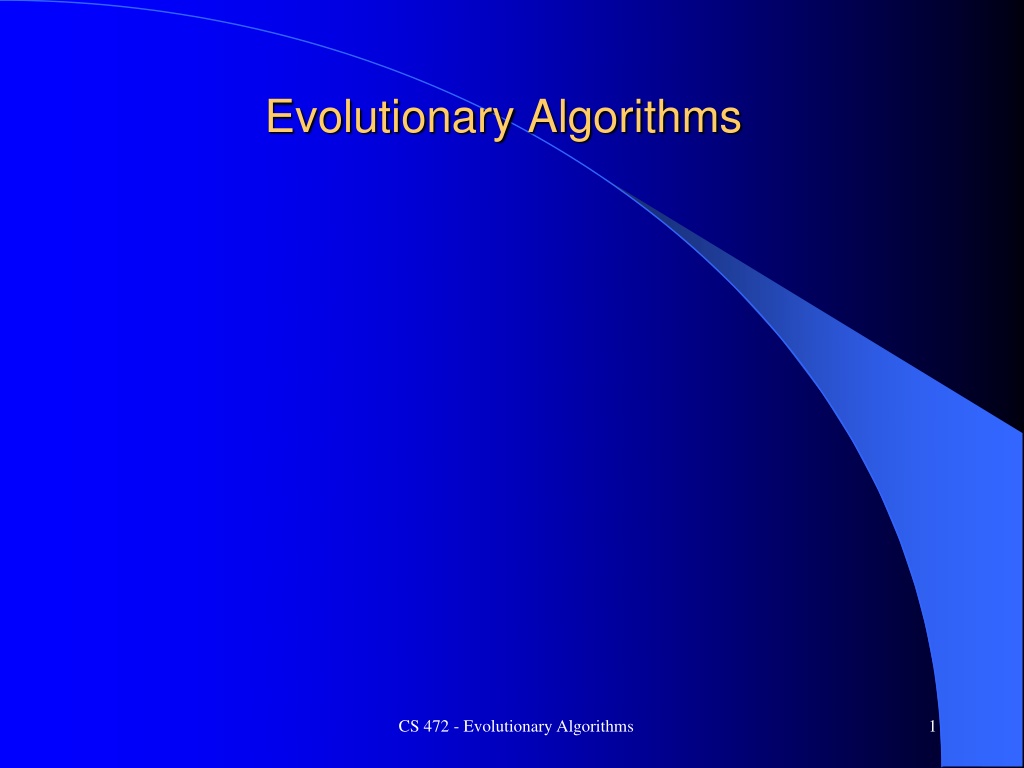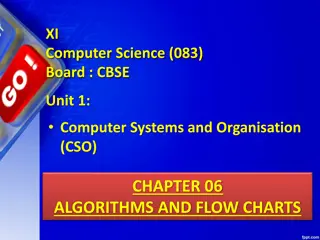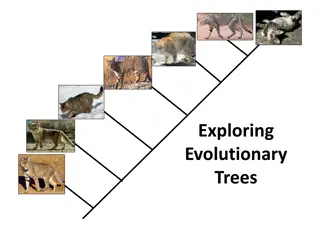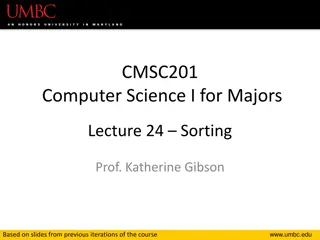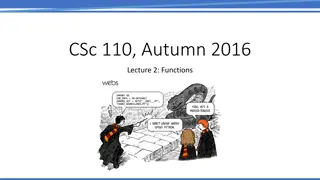Understanding Evolutionary Algorithms in Computer Science
Evolutionary algorithms, particularly genetic algorithms, simulate natural evolution to optimize parameters and discover new solutions. By creating genomes representing potential solutions and using genetic operators like mutation and crossover, these algorithms populate a search space, conduct local and exploratory searches, and select promising candidates based on fitness for survival. This approach is widely used in optimization problems such as the knapsack with repetition.
Download Presentation

Please find below an Image/Link to download the presentation.
The content on the website is provided AS IS for your information and personal use only. It may not be sold, licensed, or shared on other websites without obtaining consent from the author. Download presentation by click this link. If you encounter any issues during the download, it is possible that the publisher has removed the file from their server.
E N D
Presentation Transcript
Evolutionary Algorithms CS 472 - Evolutionary Algorithms 1
Evolutionary Computation/Algorithms Genetic Algorithms Simulate natural evolution of structures via selection and reproduction, based on performance (fitness) Type of heuristic search to optimize any set of parameters- Discovery, not inductive learning in isolation Create "genomes" which represent a current potential solution with a fitness (quality) score Values in genome represent parameters to optimize MLP weights, TSP path, knapsack, potential clusterings, etc. Discover new genomes (solutions) using genetic operators Recombination (crossover) and mutation are most common CS 472 - Evolutionary Algorithms 2
Evolutionary Computation/Algorithms Genetic Algorithms Populate our search space with initial random solutions Use genetic operators to search the space Do local search near the possible solutions with mutation Do exploratory search with recombination (crossover) Example: Knapsack with repetition Given items x1, x2, , xn each with weight wi and value vi find the set of items which maximizes the total value xivi under the constraint that the total weight of the items xiwidoes not exceed a given W CS 472 - Evolutionary Algorithms 3
Evolutionary Computation/Algorithms Genetic Algorithms Populate our search space with initial random solutions Use genetic operators to search the space Do local search near the possible solutions with mutation Do exploratory search with recombination (crossover) 1 1 0 2 3 1 0 2 2 1 (Fitness = 60) 2 2 0 1 1 3 1 1 0 0 (Fitness = 72) 1 1 0 2 1 3 1 1 0 0 (Fitness = 55) 2 2 0 1 3 1 0 2 2 1 (Fitness = 88) CS 472 - Evolutionary Algorithms 4
Evolutionary Algorithms Start with initialized population P(t) - random, domain- knowledge, etc. Typically have fixed population size (type of beam search), large enough to maintain diversity Selection Parent_Selection P(t) - Promising Parents more likely to be chosen based on fitness to create new children using genetic operators Survive P(t) - Pruning of less promising candidates, Evaluate P(t) - Calculate fitness of population members. Could be simple metrics to complex simulations. Survival of the fittest - Find and keep best while also maintaining diversity CS 472 - Evolutionary Algorithms 5
Evolutionary Algorithm Procedure EA t = 0; Initialize Population P(t); Evaluate P(t); Until Done{ /*Sufficiently good individuals discovered or many iterations passed with no improvement, etc.*/ t = t + 1; Parent_Selection P(t); Crossover P(t); Mutate P(t); Evaluate P(t); Survive P(t);} CS 472 - Evolutionary Algorithms 6
Example Knapsack w/repetition Given items x1, x2, , xn each with weight wi and value vi find the set of items which maximizes the total value xivi under the constraint that the total weight of the items xiwidoes not exceed a given W if weight(x) >W 0 Item 1 2 3 4 Weight 4 1 2 3 Value $10 $2 $3 $7 |x| fitness(x) = valuei xi Otherwise i=1 2 0 3 0 F = 29 W = 15 CS 472 - Evolutionary Algorithms 7
Item 1 Weight 4 Value $10 Example W = 15 2 3 4 1 2 3 $2 $3 $7 Population size of 3 2 0 3 0 1 1 1 1 2 2 0 1 Crossover Assume we choose two highest with crossover in the middle 2 0 0 1 F = 27 Child 1 2 2 3 0 F = 0 (Over weight) Child 2 Mutation assume we just mutate first feature of Child 1 3 0 0 1 F = 37 Updated Child 1 replaces original Survival Have 5, must drop 2 (most likely drop lowest) F = 29 F = 22 F = 31 CS 472 - Evolutionary Algorithms 8
EA Example Goal: Discover a new automotive engine to maximize performance, reliability, and mileage while minimizing emissions Features: CID (Cubic inch displacement), fuel system, # of valves, # of cylinders, presence of turbo-charging Assume - Test unit which tests possible engines and returns integer measure of goodness Start with population of random engines CS 472 - Evolutionary Algorithms 9
Data Representation (Genome) Individuals are represented so that they can be manipulated by genetic operators Simplest representation is a bit string, where each bit or group of bits could represent a feature/parameter Assume the following represents a set of parameters p1 p2 p3 p4 p5 p6 p7 1 0 1 0 0 0 1 1 1 1 0 1 Could do crossovers anywhere or just at parameter breaks Can use more complex representations including real numbers, symbolic representations (e.g. programs for genetic programming), etc. CS 472 - Evolutionary Algorithms 12
Genetic Operators Crossover variations - multi-point, uniform, averaging, etc. Mutation - Random changes in features, adaptive, different for each feature, etc. More random early, less so with time Others - many schemes mimicking natural genetics: dominance, selective mating, inversion, reordering, speciation, knowledge-based, etc. CS 472 - Evolutionary Algorithms 13
Fitness Function Evaluation Each individual in the population should have a fitness based on the fitness function Fitness function will depend on the application Learning system will usually use accuracy on a validation set for fitness (note that no training set needed, just validation and test) Solution finding (path, plan, etc.) - Length or cost of solution Program - Does it work and how efficient is it Cost of evaluating function can be an issue. When expensive can approximate or use rankings, etc. which could be easier. Stopping Criteria - A common one is when best candidates in population are no longer improving over time CS 472 - Evolutionary Algorithms 15
Parent Selection In general want the fittest parents to be involved in creating the next generation However, also need to maintain diversity and avoid crowding so that the entire space gets explored (local minima vs global minima) Most common approach is Fitness Proportionate Selection (aka roulette wheel selection) Fitness(hi) |population| Pr(hi)= Fitness(hj) j=1 Everyone has a chance but the fittest are more likely CS 472 - Evolutionary Algorithms 16
Parent Selection There are other methods which lead to more diversity Rank selection Rank order all candidates Do random selection weighted towards highest rank Keeps actual fitness value from dominating Fitness scaling - Scale down fitness values during early generations. Scale back up with time. Equivalently could scale selection probability function over time. Tournament selection Randomly select two candidates The one with highest fitness is chosen with probability p, else the lesser is chosen p is a user defined parameter, .5 < p < 1 Even more diversity CS 472 - Evolutionary Algorithms 17
Tournament Selection with p = 1 Biagio D Antonio, b. 1446, Florence, Italy - Saint Michael Weighing Souls - 1476
Survival - New Generation Population size - Larger gives more diversity but with diminishing gain, small sizes of ~100 are common How many new offspring will be created at each generation (what % of current generation will not survive) Keep selecting parents without replacement until quota filled An equal number of candidates must be removed to maintain the population constant Many variations Randomly keep best candidates weighted by fitness No old candidates kept Always keep a fixed percentage of old vs new candidates Usually keep highest candidate seen so far (bssf) in separate memory since it may be deleted during normal evolution CS 472 - Evolutionary Algorithms 19
Evolutionary Algorithms There exist mathematical proofs that evolutionary techniques are efficient search strategies There are a number of different Evolutionary algorithm approaches Genetic Algorithms Evolutionary Programming Evolution Strategies Genetic Programming Strategies differ in representations, selection, operators, evaluation, survival, etc. Some independently discovered, initially function optimization (EP, ES) Strategies continue to evolve CS 472 - Evolutionary Algorithms 21
Genetic Algorithms Representation based typically on a list of discrete tokens, often bits (Genome) - can be extended to graphs, lists, real- valued vectors, etc. Select m pairs parents probabilistically based on fitness Create 2m new children using genetic operators (emphasis on crossover) and assign them a fitness - single-point, multi-point, and uniform crossover Replace weakest candidates in the population with the new children (or can always delete parents) CS 472 - Evolutionary Algorithms 22
Evolutionary Programming Representation that best fits problem domain All n genomes are mutated (no crossover) to create n new genomes - total of 2n candidates Only n most fit candidates are kept Mutation schemes fit representation, varies for each variable, amount of mutation (typically higher probability for smaller mutation), and can be adaptive (i.e. can decrease amount of mutation for candidates with higher fitness and based on time - form of simulated annealing) CS 472 - Evolutionary Algorithms 23
Evolution Strategies Similar to Evolutionary Programming - initially used for optimization of complex real systems - fluid dynamics, etc. - usually real vectors Uses both crossover and mutation. Crossover first. Also averaging crossover (real values), and multi-parent. Randomly selects set of parents and modifies them to create > n children Two survival schemes Keep best n of combined parents and children Keep best n of only children CS 472 - Evolutionary Algorithms 24
Genetic Programming Evolves more complex structures - programs, functional language code, neural networks Start with random programs of functions and terminals (data structures) Execute programs and give each a fitness measure Use crossover to create new programs, no mutation Keep best programs For example, place lisp code in a tree structure, functions at internal nodes, terminals at leaves, and do crossover at sub-trees - always legal in a functional language (e.g. scheme, lisp, etc.) CS 472 - Evolutionary Algorithms 25
Genetic Algorithm Example Use a Genetic Algorithm to learn the weights of an MLP. Used to be a lab. CS 472 - Evolutionary Algorithms 27
Genetic Algorithm Example Use a Genetic Algorithm to learn the weights of an MLP Used to be a lab You could represent each weight with m (e.g. 10) bits (Binary or Gray encoding), remember the bias weights Could also represent weights as real values - In this case use Gaussian style mutation Walk through an example Assume wanted to train MLP to solve Iris data set Assume fixed number of hidden nodes, though GAs can be used to discover that also CS 472 - Evolutionary Algorithms 28
Evolutionary Computation Comments Much current work and extensions Numerous application attempts. Can plug into many algorithms requiring search. Has built-in heuristic. Could augment with domain heuristics. If no better way, can always try evolutionary algorithms, with pretty good results ("Lazy man s solution" to any problem) Many different options and combinations of approaches, parameters, etc. Swarm Intelligence Particle Swarm Optimization, Ant colonies, Artificial bees, Robot flocking, etc. Research continues regarding adaptivity of population size selection mechanisms operators representation CS 472 - Evolutionary Algorithms 29
Classifier Systems Reinforcement Learning - sparse payoff Contains rules which can be executed and given a fitness (Credit Assignment) - Booker uses bucket brigade scheme GA used to discover improved rules Classifier made up of input side (conjunction of features allowing don t cares), and an output message (includes internal state message and output information) Simple representation aids in more flexible adaptation schemes CS 472 - Evolutionary Algorithms 30
Bucket Brigade Credit Assignment Each classifier has an associated strength. When matched the strength is used to competitively bid to be able to put message on list during next time step. Highest bidders put messages. Keeps a message list with values from both input and previously matched rules - matched rules set outputs and put messages on list - allows internal chaining of rules - all messages changed each time step. Output message conflict resolved through competition (i.e. strengths of classifiers proposing a particular output are summed, highest used) CS 472 - Evolutionary Algorithms 31
Bucket Brigade (Continued) Each classifier bids for use at time t. Bid used as a probability (non-linear) of being a winner - assures lower bids get some chances B(C,t) = bR(C)s(C,t) where b is a constant << 1 (to insure prob<1), R(C) is specificity (# of asserted features), s(C,t) is strength Economic analogy - Previously winning rules (t-1) suppliers (made you matchable), following winning rules (t+1) consumers (you made them matchable - actually might have made) CS 472 - Evolutionary Algorithms 32
Bucket Brigade (Continued) s(C,t+1) = s(C,t) -B(C,t) - Loss of Strength for each consumer (price paid to be used, prediction of how good it will pay off) {C'} = {suppliers} - Each of the suppliers shares an equal portion of strength increase proportional to the amount of the Bid of each of the consumers in the next time step s(C',t+1) = s(C',t) + B(Ci,t)/|C'| You pay suppliers amount of bid, receive bid amounts from consumers. If consumers profitable (higher bids than you bid) your strength increases. Final rules in chain receive actual payoffs and these eventually propagate iteratively. Consistently winning rules give good payoffs which increases strength of rule chain, while low payoffs do opposite. CS 472 - Evolutionary Algorithms 33
